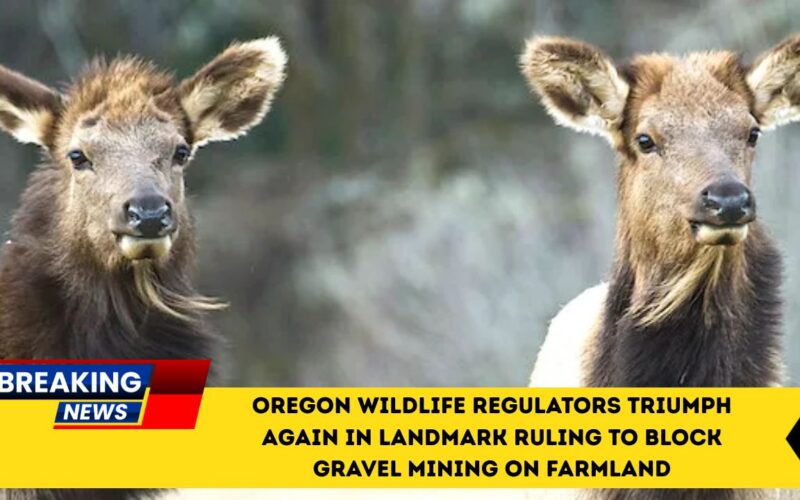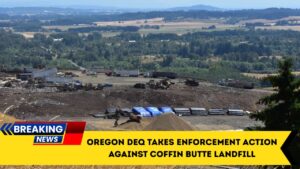In a major win for conservation and farmland preservation, regulators in Oregon have delivered yet another blow to large-scale mining plans.
A recent ruling by the Land Use Board of Appeals (LUBA) blocked Jackson County, Oregon’s decision to rezone 435 acres of prime farmland for gravel extraction—declaring that the county had failed to account for critical impacts on wildlife habitat.
This case highlights the growing clash between agricultural protection, mining interests and wildlife regulation in Oregon. Below, we unpack what happened, key numbers and what this means for future land use.
Background of the Dispute
The crux of the dispute centres on a parcel near Eagle Point, Oregon, owned by Freel & Associates, LLC, which spans approximately 1,300 acres and contains more than 500,000 tons of high-quality aggregate.
The land is largely zoned for exclusive farm use and includes designated winter range habitat for elk and deer.
Around two decades ago, some 155 acres of the parcel were split-zoned to allow mining. The landowner sought to expand mining activities by rezoning an additional 435 acres from agricultural to aggregate resource designation.
Wildlife agency objections followed, arguing that the mining proposal threatened deer and elk migration, habitat and forage quality.
Key Details of the Ruling
| Feature | Details |
|---|---|
| Size of proposed rezoned area | 435 acres to be rezoned from farm use to gravel mining |
| Total parcel size | Approx. 1,300 acres including the farmland and aggregate resource |
| Resources on site | Over 500,000 tons of high-quality aggregate |
| Main wildlife impacted | Deer and elk winter range habitat near Eagle Point |
| Regulatory body | Land Use Board of Appeals (LUBA) |
| Key deficiency cited | County failed to specify impacts of dust and noise on wildlife habitat |
LUBA sided with the Oregon Department of Fish and Wildlife (ODFW), finding that the county’s zoning decision lacked a detailed analysis of how and where dust, heavy equipment noise and habitat disruption would affect elk and deer.
The ruling states the county must perform a “more stringent analysis” and lay out exactly how, where, when and to what extent mining will disrupt the sensitive wildlife habitat.
Why the Decision Matters
Farmland, wildlife and mining at odds
This case demonstrates a key tension in Oregon land use: farmland zoned for exclusive agricultural use (EFU) also overlaps with wildlife habitat, especially in rural counties like Jackson.
When mining interests propose large-scale aggregate removal, the risk of habitat loss, noise disturbance and dust fall becomes significant.
Regulatory standards enforced
By demanding a detailed impact study, LUBA reinforces the idea that local governments cannot rubber-stamp mining rezoning without full environmental and wildlife impact disclosures.
The ruling emphasises that conditions of approval cannot defer key analysis untilafter mining begins.
Precedent for future approvals
While LUBA rejected some of ODFW’s other objections—such as the county’s requirement of a $40,000 wildlife enhancement fund per quarry as allowable—this decision still highlights stricter expectations.
Mining proponents now face higher hurdles in Oregon before aggregate operations can proceed on farmland.
What Happens Next?
The county will have to revisit the rezoning application and prepare detailed documentation showing:
- Exactly where mining will occur and which wildlife corridors it will impact
- How equipment noise levels will displace deer or elk
- How dust deposition will affect forage quality and vegetation
- When each part of mining will occur (phasing) and how habitat mitigation will work
Until such analysis is provided, the county’s previous zone change remains blocked, and mining may not proceed.
The recent victory by Oregon wildlife regulators marks a crucial moment in land use governance.
The blocking of gravel mining rezoning across 435 acres of farmland underscores the delicate balance between farm land preservation, wildlife habitat protection and mineral resource exploitation.
The ruling sends a clear message: local governments must provide specific, detailed impact analyses when wildlife habitat and farming zonings intersect. For landowners, counties and mining firms, this means more thorough preparation and stronger scrutiny ahead.
Ultimately, for Oregon’s deer, elk and farmland, it is a win for responsible stewardship.




